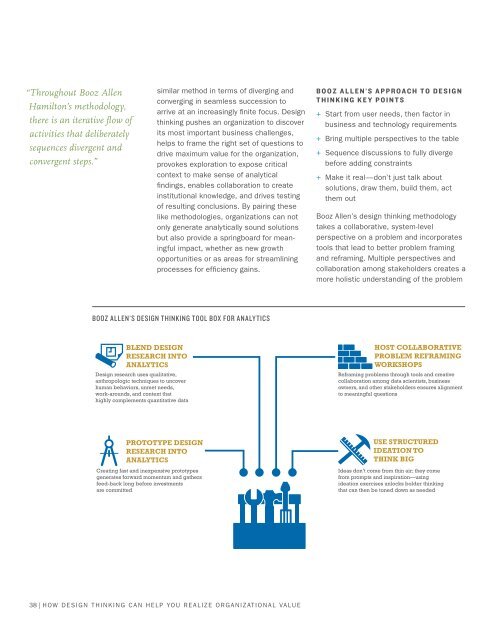Tips for Building a Data Science Capability
WH4vS
WH4vS
Create successful ePaper yourself
Turn your PDF publications into a flip-book with our unique Google optimized e-Paper software.
“Throughout Booz Allen<br />
Hamilton’s methodology,<br />
there is an iterative flow of<br />
activities that deliberately<br />
sequences divergent and<br />
convergent steps.”<br />
similar method in terms of diverging and<br />
converging in seamless succession to<br />
arrive at an increasingly finite focus. Design<br />
thinking pushes an organization to discover<br />
its most important business challenges,<br />
helps to frame the right set of questions to<br />
drive maximum value <strong>for</strong> the organization,<br />
provokes exploration to expose critical<br />
context to make sense of analytical<br />
findings, enables collaboration to create<br />
institutional knowledge, and drives testing<br />
of resulting conclusions. By pairing these<br />
like methodologies, organizations can not<br />
only generate analytically sound solutions<br />
but also provide a springboard <strong>for</strong> meaningful<br />
impact, whether as new growth<br />
opportunities or as areas <strong>for</strong> streamlining<br />
processes <strong>for</strong> efficiency gains.<br />
BOOZ ALLEN’S APPROACH TO DESIGN<br />
THINKING KEY POINTS<br />
+ + Start from user needs, then factor in<br />
business and technology requirements<br />
+ + Bring multiple perspectives to the table<br />
+ + Sequence discussions to fully diverge<br />
be<strong>for</strong>e adding constraints<br />
+ + Make it real—don’t just talk about<br />
solutions, draw them, build them, act<br />
them out<br />
Booz Allen’s design thinking methodology<br />
takes a collaborative, system-level<br />
perspective on a problem and incorporates<br />
tools that lead to better problem framing<br />
and reframing. Multiple perspectives and<br />
collaboration among stakeholders creates a<br />
more holistic understanding of the problem<br />
BOOZ ALLEN’S DESIGN THINKING TOOL BOX FOR ANALYTICS<br />
BLEND DESIGN<br />
RESEARCH INTO<br />
ANALYTICS<br />
Design research uses qualitative,<br />
anthropologic techniques to uncover<br />
human behaviors, unmet needs,<br />
work-arounds, and context that<br />
highly complements quantitative data<br />
HOST COLLABORATIVE<br />
PROBLEM REFRAMING<br />
WORKSHOPS<br />
Reframing problems through tools and creative<br />
collaboration among data scientists, business<br />
owners, and other stakeholders ensures alignment<br />
to meaningful questions<br />
PROTOTYPE DESIGN<br />
RESEARCH INTO<br />
ANALYTICS<br />
Creating fast and inexpensive prototypes<br />
generates <strong>for</strong>ward momentum and gathers<br />
feed-back long be<strong>for</strong>e investments<br />
are committed<br />
USE STRUCTURED<br />
IDEATION TO<br />
THINK BIG<br />
Ideas don’t come from thin air; they come<br />
from prompts and inspiration—using<br />
ideation exercises unlocks bolder thinking<br />
that can then be toned down as needed<br />
38 | HOW DESIGN THINKING CAN HELP YOU REALIZE ORGANIZATIONAL VALUE


